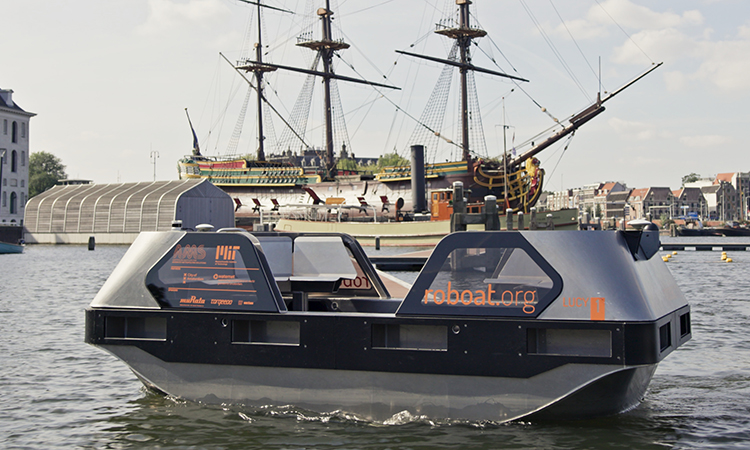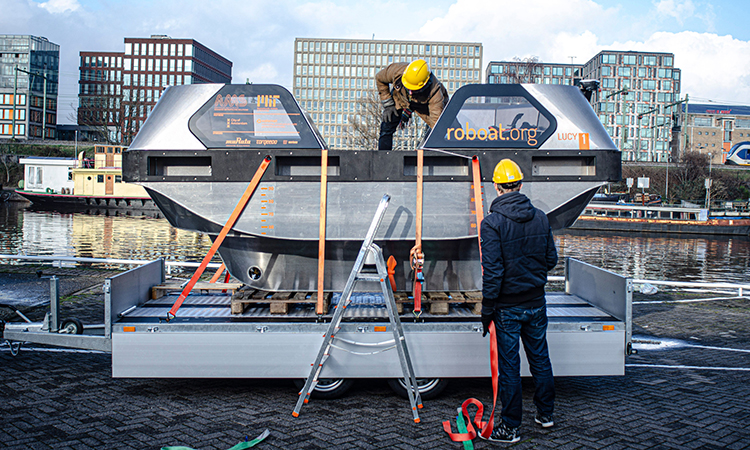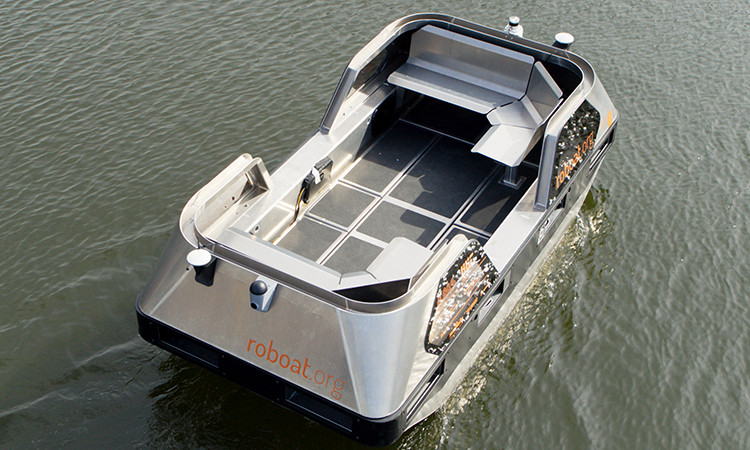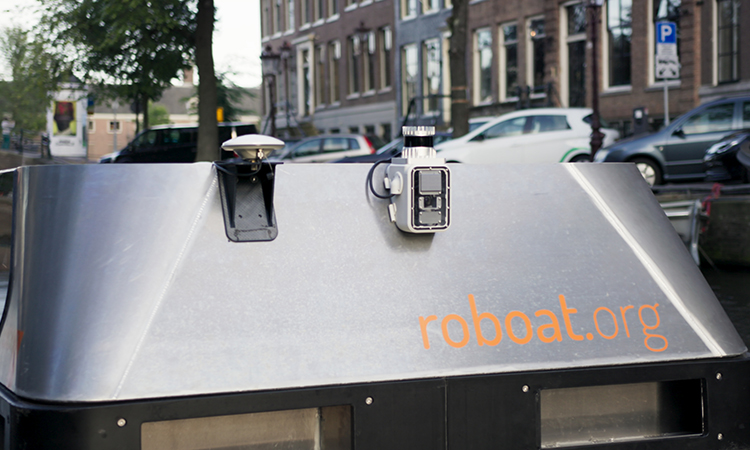Harnessing autonomous technology to unlock Amsterdam’s waterways
- Like
- Digg
- Del
- Tumblr
- VKontakte
- Buffer
- Love This
- Odnoklassniki
- Meneame
- Blogger
- Amazon
- Yahoo Mail
- Gmail
- AOL
- Newsvine
- HackerNews
- Evernote
- MySpace
- Mail.ru
- Viadeo
- Line
- Comments
- Yummly
- SMS
- Viber
- Telegram
- Subscribe
- Skype
- Facebook Messenger
- Kakao
- LiveJournal
- Yammer
- Edgar
- Fintel
- Mix
- Instapaper
- Copy Link
Posted: 28 March 2022 | Ynse Deinema - Amsterdam Institute for Advanced Metropolitan Solutions | No comments yet
Ynse Deinema, Project Coordinator – Roboat at the Amsterdam Institute for Advanced Metropolitan Solutions (AMS Institute), sat down with Intelligent Transport’s Editor, Leah Hockley, to discuss how Roboat is claiming back Amsterdam’s waterways for mobility, and how the use of autonomous vessels is key to maximising its potential.


Credit: MIT and AMS Institute
Can you give us a brief explanation of what the Roboat project is?
Roboat is all about developing a fully autonomous vessel that can operate in the urban context. We are building a boat that can sail without the need for a skipper on board, which can self-navigate and safely move from point A to B without bumping into anything.
An active fleet of Roboats in your city unlocks the potential to optimise all of your logistical planning with a shore control centre – a benefit for mobility, and also logistics.
We need to re-think what we can do with our mobility concept with our existing infrastructure”
Many cities are struggling when it comes to mobility. Our roads are clogged, congestion is increasing and vehicle emissions are harming the environment. Put simply, we need to re-think what we can do with our mobility concept with our existing infrastructure.
Amsterdam is renowned for its waterways, specifically its canals, which historically have been used for all kinds of logistical and mobility purposes. Nowadays, these are mostly used for tourism and recreation. But, with Roboat, we are providing a new, innovative platform which is fully autonomous and zero-emission.
How did the partnership between MIT and AMS come to be?
The City of Amsterdam has commissioned the Amsterdam Institute for Advanced Metropolitan Solutions (AMS Institute) to come up with technical solutions for metropolitan challenges. Roboat came about five years ago, as a solution to the problem of growing congestion in our city. With cities plagued by cars, vans and trucks, why not use our waterways?
Roboat is a collaboration between the AMS Institute in Amsterdam and the Massachusetts Institute of Technology (MIT) in the U.S. We have been collaborating for over five years now, developing the fundamentals of this autonomous technology. This includes the sensors that we deploy for perceiving the environment, the control algorithms for steering the boat and the navigation tools that we use.
The Roboat concept has come a long way since its inception. Naturally, there have been several iterations of Roboat prototypes. In the beginning, we had small boats, which were mostly tested in the swimming pool at MIT. Tests were also conducted on the Charles River in Boston, before we moved towards our full-scale boat prototypes. These are two by four metre, full-scale Roboats, which can be sat in and deployed as logistical units. These two prototypes operate in Amsterdam in the city centre, in a test area on the marine terrain.


Credit: MIT and AMS Institute – Two full-scale Roboat prototypes are currently being trialled in the city centre of Amsterdam, in a test area on the marine terrain.
What are the three use cases that are being developed, and why were these chosen?
The most obvious use case is using Roboats as water taxis or a passenger shuttle vessel, similar to a small bus, to transport passengers from point A to point B.
The other use is logistics; using the boats to transport building materials into the city, or food and drinks to Amsterdam’s hotels and restaurants, for example. Trucks entering the city to remove household waste is a huge problem in Amsterdam – another example where the use of Roboat, as a logistical unit, could offer a solution.
These two aspects, mobility and logistics, are the core use cases of Roboats.
Thirdly, there is scope to use Roboats for urban data collection purposes. For instance, we have developed a water quality sensor. Deploying multiple Roboats fitted with this sensor could provide a refined, real-time image of the state of the waters in Amsterdam.
Why was it important for this project to implement autonomy rather than choosing to develop manually driven vehicles?
That’s a really good question, because you could argue that all of the things that I’ve mentioned till now can also be done with a conventional boat, right? It’s just taking cars off of the road and moving those movements towards the existing water infrastructure. However, I am confident that autonomy can be a game changer in how these boats are deployed, for the following three core reasons.
Put simply, if you don’t need a skipper, then you can easily have these boats operating 24/7. In waste collection, for example, it’s very difficult to find skippers willing to work at these unsocial hours, while a Roboat will continue to provide labour as long as the battery is charged. This is a unique element of autonomy – the flexibility that it affords the city, in how these vessels can be deployed.
Secondly, a fleet of these boats allows us to compile a complete overview of where each boat is, how fast it’s going and what it’s moving towards. As such, we can optimise logistics by co-ordinating interactions between the boats and, say, a truck delivering goods from outside of the city centre, to a hub where a Roboat is waiting to carry on the journey.


Credit: MIT and AMS Institute – By 2025, all vessels in Amsterdam need to be emission-free. Roboat, as an electric, battery-powered boat, is already meeting this aim.
Thirdly, is the safety perspective. The sensors that we use provide 360-degree vision. As such, Roboats are starting to outperform the human eye in recognising objects in and on the water, particularly during the night. Needless to say, these boats significantly increase safety.
There is an extra, fourth reason for choosing autonomous boats. When considering shipping, it’s clear that there’s a scalable advantage for boats in transporting goods. The larger the boat, the greater the efficiency. As we see with the large container vessels that travel between continents, if you increase the size of that vessel, it becomes cheaper and more efficient.
While that’s great from a shipping perspective, you obviously can’t operate such a large boat in a city. So, to really make use of these waterways, you need smaller or medium-sized vessels, and a high number of these boats. But, if these boats can operate autonomously, without a skipper, that’s a huge benefit to operating a high number. It could be an enabling factor for many cities worldwide to seriously reconsider their waterways for logistical purposes.
What challenges did the Roboat team face in making the boats autonomous? How were these challenges overcome?
Honestly, we faced many challenges. Enabling autonomy is a very complex issue, you need only to take a look at what’s going on in the automotive industry to see this.
Naturally, one of the main problems is solving people’s perceptions when it comes to safety. The boat needs to be aware of its surroundings at all times. We use digital sensors, such as LIDAR, but also cameras. This data is then analysed in order to recognise various objects, whether that be another boat, or perhaps a floating object, and this is naturally a very difficult and complex process.
One of the challenges that is still keeping us occupied is ensuring that these sensors work during all weather conditions, changing of the seasons, lighting conditions, etc. – all factors that affect the precision and reliability of the reception kit. It’s a huge challenge.
It is really interesting to see the progress that we – not just the Roboat team, but technology teams worldwide – are making in tackling this problem. This is improving rapidly, truly every day. Each time we go out with the boats, we get better datasets and a more refined perception. It’s incredibly positive and encouraging to see.


Credit: MIT and AMS Institute – Roboat uses digital sensors, such as LIDAR, but also cameras to ensure that the boat is aware of its surroundings at all times.
Do you think that autonomy is the future of the transport industry?
I don’t think autonomy is the future, but I do think that it’s going to be a part of the future. Autonomy is certainly not the answer to all of our problems from a transportation point of view, but it can contribute to finding solutions in many use cases.
Autonomy is certainly not the answer to all of our problems from a transportation point of view, but it can contribute to finding solutions in many use cases”
An obvious example is if you consider car-sharing and parking lots in cities. Using autonomous vehicles would clear the city of many, many cars that are only being used for a small percentage of their time.
I see autonomy as an integral part of the future that we are moving towards, likewise in the maritime domain. Perhaps we will see autonomous boats before autonomous cars in our cities – it truly would not surprise me.
Although still obviously very much a complex project, waterways are far wider, not as crammed as roads, with lower speeds. With Roboat, we are benefiting from what is happening in the automotive industry. Many of the sensors that we use are also being deployed by the automobile industry, and as production volumes increase, prices go down.
How can the Roboat project support the sustainable development of the city of Amsterdam?
Amsterdam is troubled with many challenges, just like many other metropolitan areas worldwide. Specifically, we need to electrify our transportation system. In 2025, all vessels need to be emission-free. Roboat, as an electric, battery-powered boat, is already meeting this aim.
The more transportation that we can take off of the road and shift towards the waterways is a huge win for the city centre and the citizens of Amsterdam”
Another challenge is Amsterdam’s fragile infrastructure. In some areas, parts of the city’s historical key walls and bridges are literally falling into the water because they are in very bad shape. They were not designed for modern traffic, let alone the heavy trucks that go in, and out, of the city on a regular basis. So, the more transportation that we can take off of the road and shift towards the waterways is a huge win for the city centre and the citizens of Amsterdam. This is how we can contribute to a sustainable future for the city of Amsterdam.
What does the future look like for the Roboat project?
As I mentioned earlier, the AMS Institute has been collaborating with MIT for five years now. In October 2021, we gave a public demonstration on our achievements thus far. We held a spectacular show on the water, showing our two full-scale boats operating autonomously, even showing a trick or two, avoiding obstacles and carrying out special manoeuvres. They even docked to a docking station.
We have a special mechanism for connecting to our docking station so that people can board and off board the vessel. The positive feedback that we received led to the decision to commercialise this technology, which is what we are working on right now. We are trying to create a spinoff company based on Roboat technology.
There are many cities just in Europe that are based around waterfronts that could benefit tremendously from making more use of that space – that scarce space that you have in a city”
Now, we are starting to think more and more as a company, while trying to implement Roboat technology in existing services that are being provided on the water in Amsterdam. For example, we are going to collaborate with a company that is collecting household waste to make one of their boats fully autonomous. We are also starting to work on one of the ferry designs that can take people from A to B here in Amsterdam’s city centre, to pilot what can be done with this technology. I think that it’s a positive and highly relevant message that we are portraying to the outside world, that we are taking the next step with Roboat.
We hope that it will go further, and we certainly anticipate Roboat technology being successful beyond Amsterdam. There are many cities just in Europe that are based around waterfronts that could benefit tremendously from making more use of that space – that scarce space that you have in a city. Deploying boats is a good idea, but deploying Roboats is an even better idea.
Ynse Deinema is an experienced sailor and robotics enthusiast. He is also the Project Coordinator for Roboat at the AMS Institute in Amsterdam. Deinema strongly believes that autonomous technology will accelerate the deployment of commercial vessels in cities worldwide, and the AMS Institute and MIT are performing water tests in Amsterdam on a daily basis with their Roboat prototypes – making the technology more precise and robust.
Related topics
Air Quality, Alternative Power, Connected & Autonomous Vehicles, Fleet Management & Maintenance, Infrastructure & Urban Planning, Mobility Services, Passenger Experience, Public Transport, Sustainable Urban Transport, Traffic Management, Transport Logistics, Vehicle & Passenger Safety
Issue
Issue 1 2022
Related modes
Boat
Related cities
Amsterdam
Related countries
The Netherlands
Related organisations
Amsterdam Institute for Advanced Metropolitan Solutions (AMS Institute), Massachusetts Institute of Technology (MIT), Roboat
Related people
Ynse Deinema








